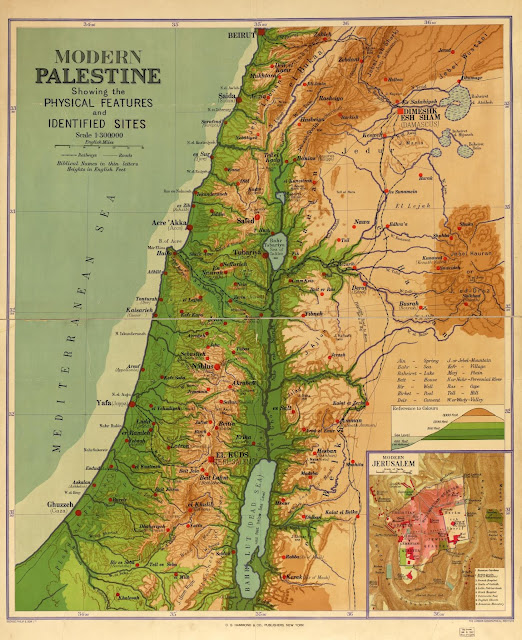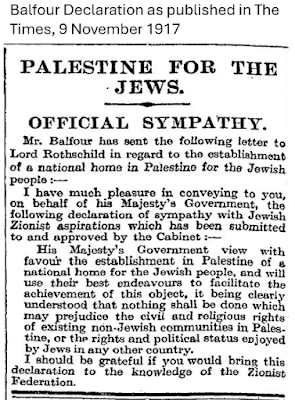Nonfiction: History
“A colonial war (in 1917) waged against the
indigenous population, by a variety of parties, to force them to relinquish
their homeland to another people against their will.”
“Significantly, the overwhelming Arab majority of the
population (around 94 percent at that time) went unmentioned by Balfour, except
in a backhanded way as the ‘existing non-Jewish communities in Palestine.’ They
were described in terms of what they were not, and certainly not as a nation or
a people—the words “Palestinian” and “Arab” do not appear in the sixty-seven
words of the declaration… By way of contrast, Balfour ascribed national
rights to what he called ‘the Jewish people,’ who in 1917 were a tiny
minority—6 percent—of the country’s inhabitants.”
 |
| Palestine 1916 |
The author frequently compares the Irish rebellion of 1919-21 to the Palestinian rebellion of 1936-39. He comments that the British used veteran "Black and Tan" soldiers of the Irish rebellion. The "Black and Tans" were renowned for their cruelty. Many of them were criminals that Britain released in return for being part of the force suppressing the Irish rebellion.
Due to British support, the Zionist movement after 1939 was provided with 2 advantages: (1) they had an emerging military force and (2) it greatly weakened the native population. The subsequent 1947-48 war between the Palestinians and Jewish settlers saw the Zionists win and steal more land and homes from thousands of Palestinians. This theft is continuing today, and Israel calls it "settlements" and they even go as far as to say Palestinians do not and did not ever exist!
“It was not as if there was a Palestinian people in
Palestine and we came and threw them out and took their country away from them.
They did not exist.” – Israeli Prime Minister Golda Meir,
June 15, 1969
Although initially not overtly supportive, the United States
changed its somewhat neutral stance to Pro-Israel during the Johnson
Administration. Unfortunately, this has drawn our country into this “colonial
settler” versus “indigenous people” conflict. Our nation is complicit in the
theft of Palestinian land, in that gives billions of dollars yearly to Israel.
Israel has the upper hand while Palestinians are forced to become refugees in
foreign lands that, for the most part, do not want them.
Readers Across the Seas Book Club Nonfiction:
History, Travel, Memoir (Palestine)
The author, Shehadeh, began researching his
family history and he discovered a great uncle, Najib Nassar. At the outbreak
of war in 1914, Uncle Najib was put on a wanted list by the Ottoman authorities
in Palestine when he voiced his opposition to participation in the conflict.
Najib went on the run. Shehadeh decided to follow in his uncle’s footsteps.
We cut back and forth between Najib's timeline and the
present as Shehadeh traces his uncle's journey, and the events that led up to
the collapse of the Ottoman Empire, the Nakba (Catastrophe) of 1948, and
beyond.
Shehadeh unearths powerful connections between Najib's
encounters as a journalist who proudly defined his identity as an Arab Ottoman,
despite accusations of treason, and his own struggle as a campaigning
Palestinian lawyer and activist.
"Both Najib and I were non-combatants who saw our
role in the realm of advocacy: I through the law, my great-great-uncle through
journalism. In retrospect I realize that we both attributed too much
significance to our form of struggle. [...] It soon became evident that Israel
was bent on seizing Palestinian land and was using a veneer of legality to
conceal its actions. [...] To my great dismay, law and legality did not prove
to be decisive weapons in our battle against Israeli colonialism."
Part travelogue, part memoir and part elegy to a lost
ecology, A Rift in Time explores how the stability of geography
and the continuity of the land have disappeared from the life of Palestinians. Given
that A Rift in Time was first published in 2010, and must now, in
2025, be read considering the current, ongoing slaughter taking place in Gaza,
I wonder if Shehadeh would shift his focus away from ecology. Would he even be
able to write this story now, considering the even tighter restrictions on
movement the Palestinians are facing?
In A Rift in Time Raja Shehadeh expressed his
frustration with “the numerous checkpoints and the abominable wall.”
There is a documentary film entitled “Wall” (the filmmaker is
Simone Bitton, an Arab Jew), about the “abominable wall.” It is available, free, streaming via your
public library’s Kanopy app.
Wall explores the separation fence that is
destroying one of the most historically significant landscapes in the world,
while imprisoning one people and enclosing the other.
This is not a Ken-Burns-Type-Production with still photos
and a musical soundtrack. Much of the movie features long pans of the wall
itself, an immersion of sight and sound into what it is like to live with the
wall. There are off-screen and on-screen conversations with children, Israelis
(including a man who was born and still lives on a Kibbutz and a settler), and
Palestinians. These are interspersed with interview segments with the Director
General of the Israeli Ministry of Defense. He explains the why and how of the
wall. (His manner and exit at the end of the film are interesting.) You will
see teenage soldiers enforcing the “wall” concept at a checkpoint; how visitors
are “greeted” at Rachel’s Tomb; and how the wall impacts people’s “commute”
during their daily activities.
NOTE: Some people have called this film “sleepy.” Yes, it is slow compared to other films about the Israeli-Palestinian conflict. There is no violence, just regular people trying to live with the wall. If you watch it, you can make up your own mind! 1 hour, 36 minutes, subtitled in English (Arabic, Hebrew)









No comments:
Post a Comment